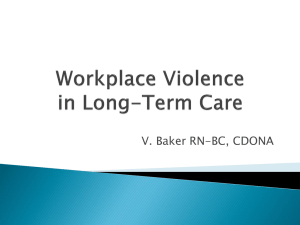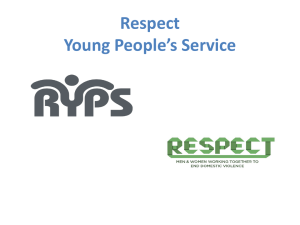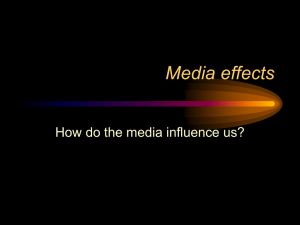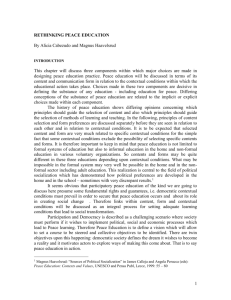(SRGBV) Prevention and Response Programming * a desk review
advertisement
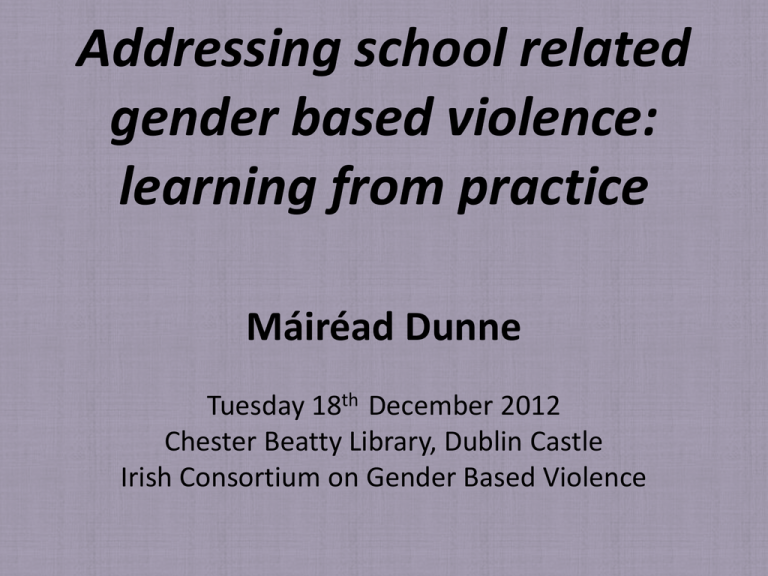
Addressing school related gender based violence: learning from practice Máiréad Dunne Tuesday 18th December 2012 Chester Beatty Library, Dublin Castle Irish Consortium on Gender Based Violence Promising Practice in School Related Gender Based Violence (SRGBV) Prevention and Response Programming – a desk review Fiona Leach, Eric Slade and Máiréad Dunne Centre for International Education University of Sussex Commissioned by Concern Why is School Related Gender Based Violence (SRGBV) important? • • • • • • Human Rights Women’s Rights Educational Rights EFA & MDGs Quality Equalities Difficulties and Tensions Definitional • What do we mean by gender? • What do we mean by violence? • Why the school? Contextual • International priorities and discourses • National priorities and policies • Local social and cultural understandings and practices • Research and knowledge practices Practical • Consensus, capacity and strategic approach • Sensitivities and silences Gender Theories Inclusive Education & Gender Equity Policy Practice Biting the bullet – where are we coming from? • Theorising Gender [a key social structure; a binary category; nominal and relational; determinism, stereotypes & hetero-normativity] • Being and becoming (somebody/ a citizen) [Gender as relational and learned; identity (place and space); gender and sexuality; performance & practice; femininities & masculinities] • Institutions [Gender regimes - power, practices & cultures; social regulation; intersectional identities (e.g. Age/ social class); Normal >>>> Natural >>>> Neutral] SRGBV – the basics • Patterns of gender and age/authority relations in schools – Position people differently (F/M, HT/ T/P, senior/junior) – Power regimes normalise social relations interactions often amplified in more explicit forms of gender violence – Work against teacher intervention in the ‘natural’ order • Institutional power and relations are reproduced through coercion of ‘others’ and self regulation. • Forms of violence include combinations of physical, verbal, sexual, psychological & symbolic • Violence is manifest in harassment / bullying / segregation / exclusion /corporal punishment /sexual abuse / defilement / restriction / silence /disempowerment…. Disciplinary Regimes Teaching resources Gender segregation 1 Gender segregation 2 SRGBV is centrally important! Concern and SRGBV • CONCERN – Central Focus on poverty, inequality and vulnerability – access, quality /equality in Basic Education Policy (2003) – GBV prevention and response in Strategic Plan (2004) • Gender equality highlighted throughout and SRGBV integrated within education programmes • P4 (Programme participation protection policy) signed by all employees, partners and associates Key questions for Concern • Where has there been successful intervention in SRGBV? • How was this accomplished? • What examples of good practice are available? • What M&E process was used? What indicators and evidence is available? • Is the integration of SRGBV with education the best way to address it? The review: selected agencies and projects Actionaid International /Institute of Education London • Stop Violence against Girls in School (SVAGS), Ghana, Kenya, Mozambique, 2008-13 • Transforming Education for Girls in Nigeria and Tanzania (TEGINT), 2007-12 USAID • Safe Schools Program in Ghana and Malawi, 2003-8 • C-Change SRGBV Prevention Project, DRC, 2010-12 Plan International • Promoting Safe, Child-friendly Schools in Uganda, 2008-11; Prevention of SRGBV in Uganda (with Raising Voices), 2012-14 • Learn without Fear in Malawi, 2008-10 (N.B. All based in areas where the organisation had previously worked) Other Freestanding interventions that focused on SRGBV Studies on Violence but without gender analysis The approaches – commonalities • gender as socially constructed • a rights based approach • broad view of SRGBV (in line with UN definitions of GBV) • multi-level intervention to maximise impact and sustainability • mixed methodology (data collection and project activities, qualitative and quantitative data) • a participatory and inclusive approach (with partner organisations and wide range of stakeholders). The review: 5 intended outcomes 1. A legal and policy framework that addresses violence against children in and around school, especially girls (macro level) 2. Improved prevention and response mechanisms (macro, meso and micro level) 3. Increased awareness of SRGBV and attitude and behaviour change (macro, meso and micro level) 4. Provision of a safe learning environment, especially for girls, i.e. reduction in school violence (micro level) 5. Increased enrolment and retention, especially of girls (micro level). Shared activities – national level National level • Advocacy to change policy and legislation • Collaborating with government bodies and teachers’ unions on a strengthened national teachers’ code of conduct • Creating coalitions and networks of agencies and media networks • Lobbying for appropriate mechanisms for reporting and responding to cases • Promoting media campaigns Shared activities – community level Community level • Training and awareness raising for a wide range of stakeholders • Informing and mobilising communities about child rights and violence against children, how to make schools safe, effective violence reporting mechanisms • Children’s participation in district and national schemes, e.g. • Encouraging role models / champions Shared activities – school level School level • Extra-curricular activities: school or youth clubs, debates, public speaking and mock parliaments, peer networks and peer educators, exchange visits • Physical improvements: sex-specific latrines, clean classrooms and school compounds, fencing etc • Child-friendly learning environments: school codes of conduct, class charters, suggestion boxes, alternative means of discipline • Training in gender awareness, child protection, SRGBV, complaints and referral procedures, positive discipline, gender-responsive pedagogy etc • Training manuals for specific groups of stakeholders • Student representation: participation in student councils, SMC/ PTA meetings • Developing effective referral systems to deal with reported cases • Curriculum development: preparation of life skills and gender awareness materials Learning from Practice: 6 points 1. Multi-level approaches for coherent change micro & meso & macro 2. M&E is vital & at its best it should include baseline / mid-term/ end-line quantitative & qualitative data 3. Advocacy and communications are key media watch & publicity public knowledge and interest technologies of communication professional buy-in Learning from Practice: 6 points 4. Staffing training in theories and practices champions, commitment, continuity data collection, analysis & ethics 5. Voice and representation pupils/students, females & excluded informal spaces, clubs 6. Institutions and resources safe spaces, toilets reporting and safety mechanisms codes of conduct curriculum watch (intended and actual)






